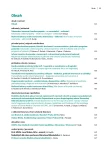How to treat dyslipidemia in patients with metabolic syndrome
Authors:
Vladimír Soška 1,2
Authors‘ workplace:
ICRC – Mezinárodní centrum klinického výzkumu, oddělení kardiovaskulárních chorob, FN u sv. Anny v Brně, ředitel Gorazd B. Stokin, M. D., MSc., Ph. D.
; Oddělení klinické biochemie FN u sv. Anny v Brně, přednosta prof. MUDr. Vladimír Soška, CSc.
1; II. interní klinika LF MU a FN u sv. Anny v Brně, přednosta prof. MUDr. Miroslav Souček, CSc.
2
Published in:
Vnitř Lék 2015; 61(7-8): 721-724
Category:
Vanýsek´s day 2015
Overview
Typical feature of dyslipidemia in patients with metabolic syndrome is increase triglycerides, decrease HDL-cholesterol and prezence of small atherogenic LDL particle; nevertheless majority of patients do not reach target level of LDL-cholesterol for their risk category as well. An essential part of treatment should be non-pharmacological approach – lifestyle changes (weight loss, change in eating habits, increased physical activity). In patients in primary prevention without diabetes decision about pharmacotherapy depend on their risk of fatal cardiovascular events in the perspective of 10 years (table SCORE). In diabetic patients and in patients in secondary prevention is pharmacotherapy indicated, unless their LDL-cholesterol does not reach its target values. The primary goal of treatment is LDL-cholesterol, so pharmacotherapy should be started with statins. If the target of LDL-cholesterol is reached and hypertriglyceridemia and/or low HDL-cholesterol persist, it is recommended to add fenofibrate to statin.
Key words:
fenofibrate – HDL-cholesterol – LDL-cholesterol – metabolic syndrome – statins – triglycerides
Sources
1. Expert Panel on Detection, Evaluation, and Treatment of High Blood Cholesterol in Adults. Executive Summary of The Third Report of The National Cholesterol Education Program (NCEP) Expert Panel on Detection, Evaluation, And Treatment of High Blood Cholesterol In Adults (Adult Treatment Panel III). JAMA 2001; 285(19): 2486–2497.
2. Grundy SM, Hansen B, Smith SC et al. Clinical management of metabolic syndrome: report of the American Heart Association/National Heart, Lung, and Blood Institute/American Diabetes Association conference on scientific issues related to management. Circulation 2004; 109(4): 551–556.
3. Griffin BA, Freeman DJ, Tait GW et al. Role of plasma triglyceride in the regulation of plasma low density lipoprotein (LDL) subfractions: relative contribution of small, dense LDL to coronary heart disease risk. Atherosclerosis 1994; 106(2): 241–253.
4. Arsenault BJ, Lemieux I, Despres JP et al. The hypertriglyceridemic-waist phenotype and the risk of coronary artery disease: results from the EPIC-Norfolk prospective population study. CMAJ 2010; 182(13): 1427–1432.
5. Catapano AL, Reiner Z, De Backer G et al. ESC/EAS Guidelines for the management of dyslipidaemias The Task Force for the management of dyslipidaemias of the European Society of Cardiology (ESC) and the European Atherosclerosis Society (EAS). Atherosclerosis 2011; 217(1): 3–46.
6. Perk J, De Backer G, Gohlke H et al. European Guidelines on cardiovascular disease prevention in clinical practice (version 2012). The Fifth Joint Task Force of the European Society of Cardiology and Other Societies on Cardiovascular Disease Prevention in Clinical Practice (constituted by representatives of nine societies and by invited experts). Eur Heart J 2012; 33(13): 1635–1701.
7. Catapano AL, Reiner Z, De Backer G et al. ESC/EAS Guidelines for the management of dyslipidaemias The Task Force for the management of dyslipidaemias of the European Society of Cardiology (ESC) and the European Atherosclerosis Society (EAS). Atherosclerosis 2011; 217(1): 3–46.
8. Vaverkova H, Soska V, Rosolova H et al. Czech Atherosclerosis Society Guidelines for the diagnosis and treatment of dyslipidemias in adults. Vnitř Lék 2007; 53(2): 181–187.
9. Cheung BM, Lauder IJ, Lau CP et al. Meta-analysis of large randomized controlled trials to evaluate the impact of statins on cardiovascular outcomes. Br J Clin Pharmacol 2004; 57(5): 640–651.
10. Soška V. Lékové interakce statinů. Hypertenze a kardiovaskulární prevence 2013; 2(4): 32–36.
11. Saha SA, Arora RR. Fibrates in the prevention of cardiovascular disease in patients with type 2 diabetes mellitus – a pooled meta-analysis of randomized placebo-controlled clinical trials. Int J Cardiol 2010; 141(2): 157–166.
12. Deedwania P, Singh V, Davidson MH. Low high-density lipoprotein cholesterol and increased cardiovascular disease risk: an analysis of statin clinical trials. Am J Cardiol 2009; 104(10 Suppl): 3E-9E. Dostupné z DOI: <http://dx.doi.org/10.1016/j.amjcard.2009.09.013>.
13. Keech A, Simes RJ, Barter P et al. Effects of long-term fenofibrate therapy on cardiovascular events in 9795 people with type 2 diabetes mellitus (the FIELD study): randomised controlled trial. Lancet 2005; 366(9500): 1849–1861. Erratum in Lancet 2006; 368(9545): 1420.
14. Group AS, Ginsberg HN, Elam MB et al. Effects of combination lipid therapy in type 2 diabetes mellitus. N Engl J Med 2010; 362(17): 1563–1574.
15. Jun M, Foote C, Lv J et al. Effects of fibrates on cardiovascular outcomes: a systematic review and meta-analysis. Lancet 2010; 375(9729): 1875–1884.
16. Jones PH, Davidson MH. Reporting rate of rhabdomyolysis with fenofibrate + statin versus gemfibrozil + any statin. Am J Cardiol 2005; 95(1): 120–122.
17. Wu CC, Hsu TL, Chiang HT et al. Efficacy and safety of slow-release fluvastatin 80 mg daily in Chinese patients with hypercholesterolemia. J Chin Med Assoc 2005; 68(8): 353–359.
18. Jones P, Kafonek S, Laurora I et al. Comparative dose efficacy study of atorvastatin versus simvastatin, pravastatin, lovastatin, and fluvastatin in patients with hypercholesterolemia (the CURVES study). Am J Cardiol 1998; 81(5): 582–587.
Labels
Diabetology Endocrinology Internal medicineArticle was published in
Internal Medicine

2015 Issue 7-8
Most read in this issue
- Ordinary disease – appendicitis
- Transcatheter aortic valve implantation – diagnostic, procedure and outcomes
- Hepatorenal syndrome – pathophysiology, diagnosis and treatment
-
Erectile dysfunction as the first sign of systemic vascular diseases and of organovascular arterial ischemic diseases.
Guidelines and Challenge of the Angiology section of Slovak Medical Chamber (AS SMC, 2015)
